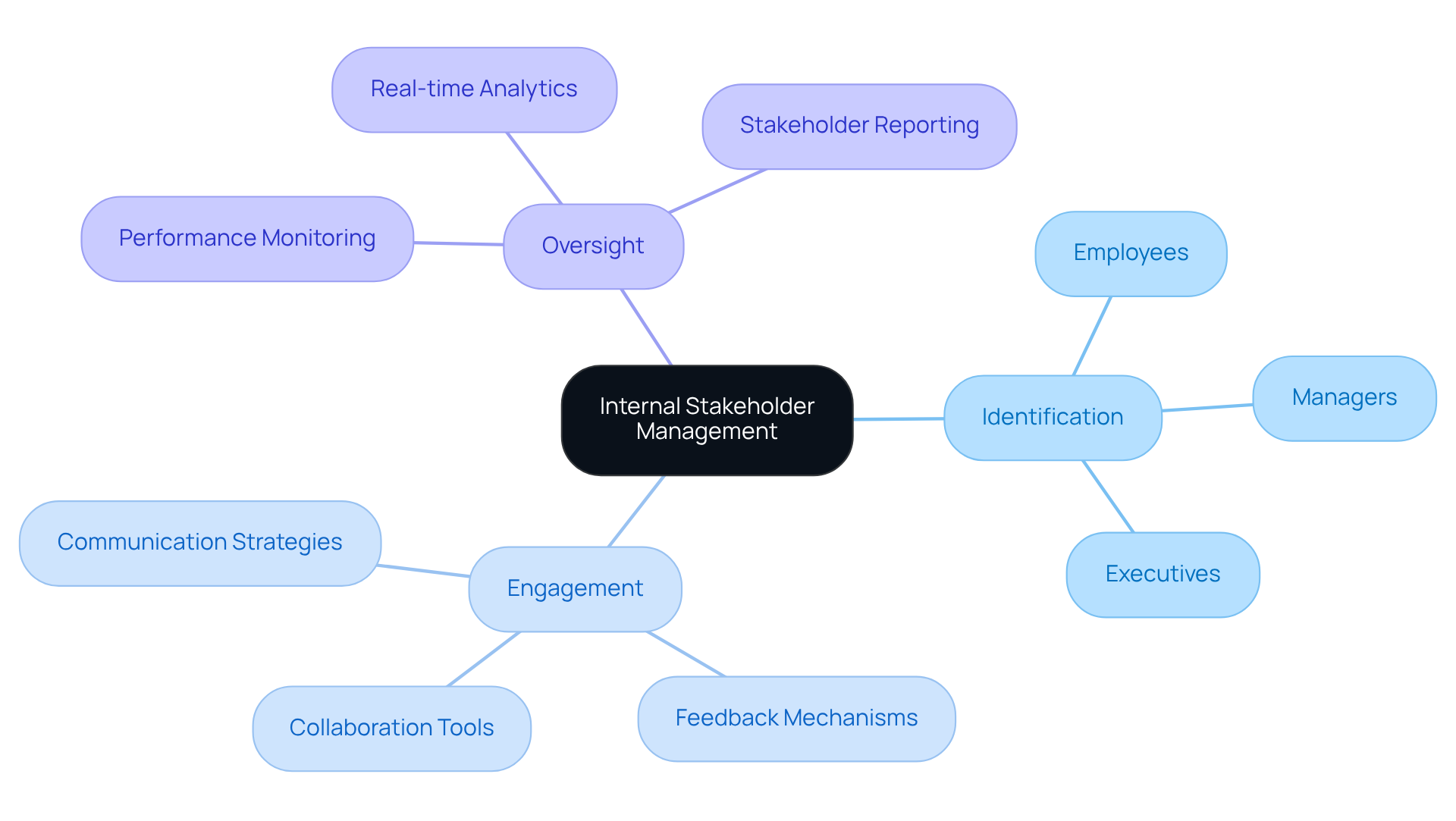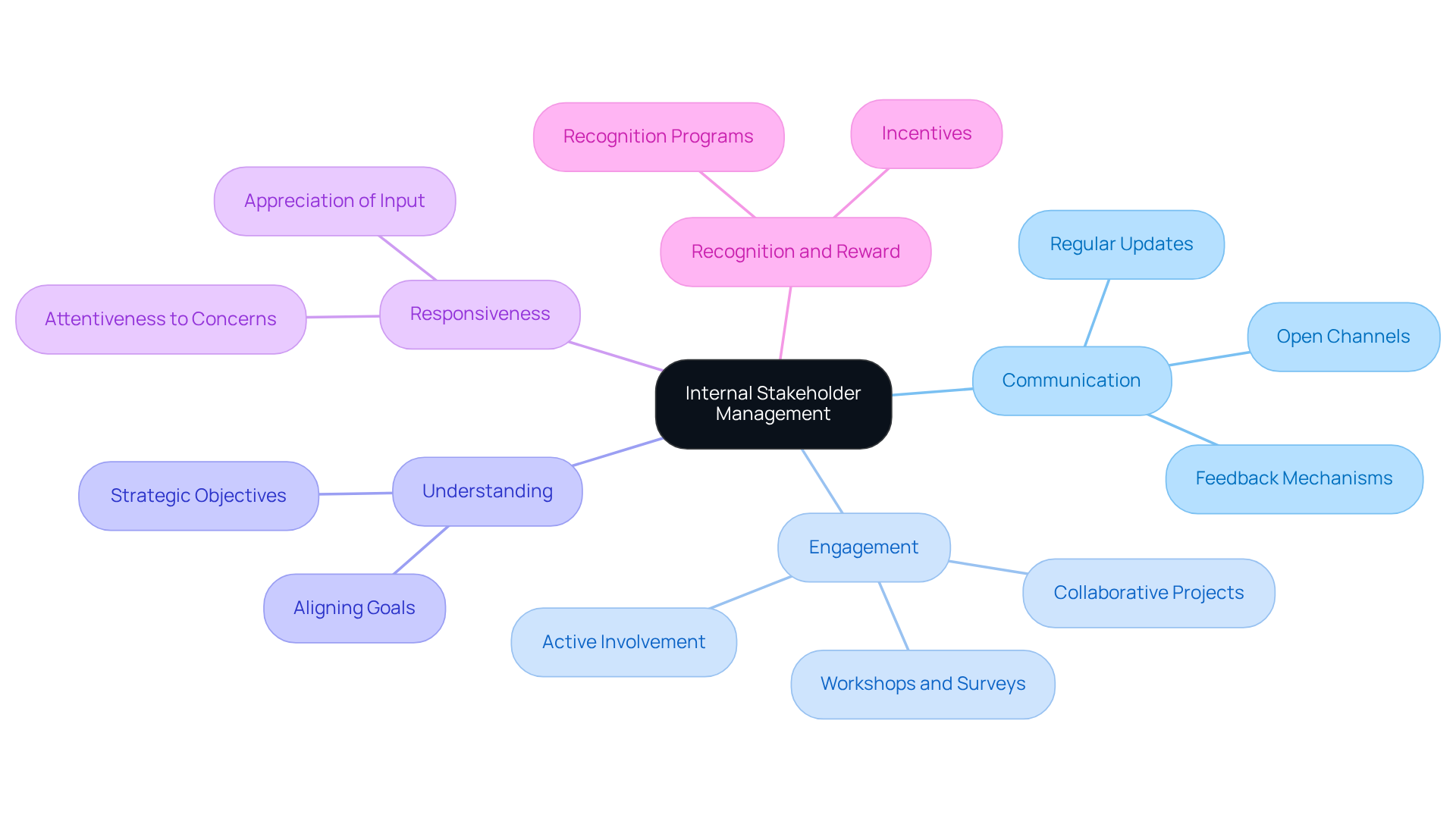Overview
Internal stakeholder management is a critical process that involves identifying, engaging, and overseeing individuals or groups within an organization who have a vested interest in its success, including employees, managers, and executives. Effective internal stakeholder management not only enhances communication but also fosters collaboration and aligns organizational goals. Consequently, it drives superior business outcomes by improving engagement and responsiveness to stakeholder needs. Embrace this strategic approach to realize the full potential of your organization.
Introduction
Internal stakeholder management is crucial for organizational success, encompassing the complex dynamics between employees, managers, and executives who share a vested interest in the company's achievements. By fostering effective communication and engagement, businesses can align their internal participants with strategic objectives, ultimately enhancing performance and collaboration.
However, as companies navigate the complexities of modern work environments, they often encounter challenges such as resistance to change and conflicting interests among stakeholders.
How can organizations effectively manage these internal relationships to not only mitigate challenges but also unlock the full potential of their workforce?
Define Internal Stakeholder Management
What is internal stakeholder management? It is a critical process that involves identifying, engaging, and overseeing individuals or groups within a company who have a vested interest in its success. These stakeholders typically include employees, managers, and executives, which highlights what is internal stakeholder management in the company's operations and decision-making processes.
Understanding what is internal stakeholder management is crucial for effective management of internal participants, ensuring alignment with the entity's goals, promoting cooperation, and enhancing overall performance. Moreover, by utilizing tools such as the client dashboard, organizations can access real-time analytics that continuously monitor business performance. This integration of real-time data not only meets the needs and expectations of stakeholders but also fosters stronger, enduring relationships, ultimately resulting in a more cohesive work environment.

Contextualize Internal Stakeholder Management
Internal participant oversight is increasingly recognized as a vital component of effective organizational governance. In the complex landscape of today's business environment, organizations face numerous challenges, including rapid technological advancements, shifting market dynamics, and changing employee expectations. By prioritizing what is internal stakeholder management, companies can significantly enhance employee engagement, improve communication, and cultivate a culture of collaboration. This approach not only boosts operational efficiency but also clarifies what is internal stakeholder management by aligning the workforce with the organization's strategic objectives, ultimately driving superior business outcomes.
Moreover, leveraging real-time analytics through a client dashboard allows organizations to continuously monitor performance and make timely, informed decisions. This ensures that internal participants remain engaged and aligned with the company's turnaround strategies. By rigorously testing hypotheses and operationalizing lessons learned from these processes, businesses can forge strong, enduring relationships that further strengthen their governance and performance.
Trace the Evolution of Stakeholder Management
The evolution of interest group management has been significant since its inception. Initially, the theory focused primarily on external parties, such as customers and investors. However, as organizations recognized the importance of inherent interactions, the emphasis expanded to include what is internal stakeholder management among internal participants as well. This shift can be traced back to R. Edward Freeman's work in the 1980s, which underscored the necessity for organizations to consider all stakeholders in their decision-making processes. Over the years, understanding what is internal stakeholder management has highlighted the influence of key participants on organizational success, leading to the development of more structured methods for engaging with them and integrating this approach into strategic planning and operational frameworks.
Identify Key Characteristics of Internal Stakeholder Management
Key characteristics of internal stakeholder management include:
- Communication: Open and transparent channels are essential for understanding the needs and expectations of involved parties. Regular updates and feedback mechanisms foster trust and collaboration.
- Engagement: Engagement is crucial in understanding what is internal stakeholder management, as it involves actively involving participants from within the organization in decision-making processes to enhance their commitment and alignment with organizational goals. This can be achieved through workshops, surveys, and collaborative projects.
- Understanding: Understanding what is internal stakeholder management is crucial for ensuring that the goals of involved parties correspond with the entity's strategic objectives to foster a unified direction.
- Responsiveness: Being attentive to the concerns and feedback of organizational members shows that their input is appreciated, which can boost morale and productivity.
- Recognition and Reward: Acknowledging the contributions of internal participants through recognition programs and incentives can motivate them to perform at their best, reinforcing their commitment to the company.

Challenges in Internal Stakeholder Management
Organizations must efficiently address the various challenges that arise in handling what is internal stakeholder management. Key issues include:
- Resistance to Change: Employees frequently resist management's proposed changes, especially when they feel their interests are overlooked. To counter this, promoting open communication and actively engaging participants in the change process can significantly reduce resistance. Understanding the emotional landscape of employees is crucial during transitions, as noted by leaders. Empathy emerges as a critical leadership skill that enables leaders to connect with employees during these transformative times.
- Conflicting Interests: Internal participants often have competing priorities, complicating the alignment of objectives. Employing mapping and prioritization techniques clarifies these conflicts and promotes a more unified approach to decision-making. Understanding the unspoken truths in communication is essential for effectively addressing these conflicts.
- Lack of Engagement: A disconnection from the decision-making process can lead to diminished commitment among involved parties. Implementing regular engagement initiatives fosters a sense of ownership and encourages collaboration. Case studies illustrate that constructive conflict can lead to personal and relational development, transforming challenges into opportunities for growth.
- Communication Barriers: Miscommunication can breed misunderstandings and erode trust. Establishing clear communication protocols is essential for effectively managing involved parties, ensuring that all individuals are informed and aligned. It is vital to abandon the goal of getting people to comply, focusing instead on understanding and resolving conflicts collaboratively.
- Resource Constraints: Limited resources can hinder the ability to adequately involve all internal participants. Prioritizing key participants and concentrating on high-impact engagement strategies enhances resource distribution, ensuring that efforts yield the best possible results. Ongoing enhancement and adjustment are crucial for sustaining effective participant relations, enabling organizations to respond to evolving situations efficiently.
By strategically addressing these challenges, organizations can improve what is internal stakeholder management, leading to enhanced collaboration and successful change initiatives.
Conclusion
Internal stakeholder management stands as a cornerstone for organizational success, underscoring the necessity of engaging and aligning employees, managers, and executives who are pivotal to a company's achievements. By adeptly managing these internal relationships, organizations can cultivate a collaborative environment that enhances performance and propels strategic objectives.
This article explores the essential characteristics of internal stakeholder management, such as open communication, active engagement, and responsiveness to feedback. It illustrates the evolution of stakeholder management, revealing how the focus has transitioned from external parties to acknowledging the critical role of internal participants in decision-making processes. Moreover, it addresses the challenges organizations encounter, including resistance to change and conflicting interests, while offering strategies to navigate these obstacles.
Ultimately, prioritizing internal stakeholder management not only fortifies governance and operational efficiency but also nurtures a culture of collaboration and trust within organizations. By recognizing the significance of internal stakeholders and implementing best practices, companies can unlock the full potential of their workforce, paving the way for sustained success and adaptability in an ever-changing business landscape.
Frequently Asked Questions
What is internal stakeholder management?
Internal stakeholder management is the process of identifying, engaging, and overseeing individuals or groups within a company who have a vested interest in its success, such as employees, managers, and executives.
Why is internal stakeholder management important?
It is crucial for effective management of internal participants, ensuring alignment with the company's goals, promoting cooperation, and enhancing overall performance.
How can organizations enhance internal stakeholder management?
Organizations can enhance internal stakeholder management by utilizing tools like client dashboards to access real-time analytics, which help monitor business performance and meet stakeholder needs.
What challenges do organizations face that make internal stakeholder management vital?
Organizations face challenges such as rapid technological advancements, shifting market dynamics, and changing employee expectations, making effective internal stakeholder management essential.
How does internal stakeholder management improve employee engagement?
By prioritizing internal stakeholder management, companies can enhance employee engagement, improve communication, and cultivate a culture of collaboration.
What role does real-time analytics play in internal stakeholder management?
Real-time analytics allow organizations to continuously monitor performance, make timely decisions, and ensure that internal participants remain engaged and aligned with the company's strategies.
How does internal stakeholder management contribute to better business outcomes?
It aligns the workforce with the organization's strategic objectives, boosts operational efficiency, and fosters strong relationships, ultimately driving superior business outcomes.




